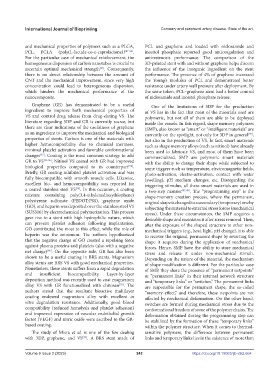Page 250 - IJB-9-2
P. 250
International Journal of Bioprinting Coronary and peripheral artery disease. State of the art.
and mechanical properties of polymers such as a PLGA, PCL and graphene and loaded with niclosamide and
PCL, PCLA (poly(L-lactide-co-ε-caprolactone)) [87-92] . inositol phosphate reported good anticoagulation and
For the particular case of mechanical reinforcement, the antirestenosis performance. The comparison of the
homogeneous dispersion of carbon nanotubes is crucial to 3D-printed stent with and without graphene helps discern
ascertain optimal mechanical strength . Consequently, the influence of the inorganic ingredient on the stent
[92]
there is no direct relationship between the amount of performance. The presence of 4% of graphene increased
CNT and the mechanical improvement, since very high the Young’s modulus of PCL and demonstrated better
concentration could lead to heterogeneous dispersion, resistance under artery wall pressure after deployment. By
which hinders the mechanical performance of the the same token, PCL–graphene stent had a better control
nanocomposite. of niclosamide and inositol phosphate release.
Graphene (GR) has demonstrated to be a useful One of the limitations of 3DP for the production
ingredient to improve both mechanical properties of of VS lies in the fact that most of the materials used are
VS and control drug release from drug-eluting VS. The polymeric, but not all of them are able to be deployed
literature regarding 3DP and GR is currently scarce, but inside the vessels. In this regard, shape memory polymers
there are clear indications of the usefulness of graphene (SMP), also known as “smart” or “intelligent materials” are
as an ingredient to improve the mechanical and biological currently on the spotlight, not only for 3DP in general ,
[97]
properties of stents. Carbon is one of the materials with but also in the production of VS. In fact, smart materials
higher hemocompatibility due to chemical inertness, such as shape memory alloys (such as nitinol) have already
minimal platelet activation and favorable conformational been used to fabricate VS, and most of them have been
changes . Coating is the most common strategy to add commercialized. SMP are polymeric smart materials
[93]
GR to VS [94-96] . Nitinol VS coated with GR had improved with the ability to change their shape while subjected to
biological properties compared to its counterpart . some triggers such as temperature, electromagnetic fields,
[94]
Briefly, GR coating inhibited platelet activation and was photo-activation, electro-activation, contact with water
fully biocompatible with smooth muscle cells. Likewise, (swelling), pH medium changes, etc. Disregarding the
excellent bio- and hemocompatibility was reported for triggering stimulus, all these smart materials are used in
a coated stainless steel VS . In this occasion, a coating a two-step manner [97,98] . The “programming step” is the
[96]
mixture containing poly(3,4-ethylenedioxythiophene) shape-memory creation process, where the permanent,
polystyrene sulfonate (PEDOT:PSS), graphene oxide original shape is changed to a secondary (temporary) one by
(GO), and heparin was deposited over the stainless steel VS subjecting the material to external stress forces (mechanical
(SUS316) by electrochemical polymerization. This process stress). Under these circumstances, the SMP acquires a
gave rise to a stent with high hydrophilic nature, which desirable shape and maintains it after stress removal. Then,
can prevent platelet adhesion following implantation. after the exposure of the shaped structure to other non-
GO contributed the most to this effect, while the role of mechanical triggers (e.g., heat, light, pH change), it is able
heparin was the minimum. The authors hypothesized to recover the original, permanent shape by reverting the
that the negative charge of GO created a repulsing force shape it acquires during the application of mechanical
against plasma proteins and platelets (also with a negative forces. Hence, SMP have the ability to store mechanical
net charge) . On the opposite side, GR has also been stress and release it under non-mechanical stimuli.
[96]
shown to be a useful coating in BRS stents. Magnesium Depending on the nature of the material, the mechanism
alloy stents are BRS VS with good mechanical properties. of shape modification is different. For the particular case
Nonetheless, these stents suffers from a rapid degradation of SMP, they share the presence of “permanent netpoints”
and insufficient biocompatibility. Layer-by-layer or “permanent links” in their internal network structure
deposition method was recently used to coat magnesium and “temporary links” or “switches.” The permanent links
alloy VS with GR functionalized with chitosan . The are responsible for the permanent shape, the so-called
[95]
authors stated that the resultant bioactive multilayer “memory effect,” and therefore, these netpoints are not
coating endowed magnesium alloy with excellent in affected by mechanical deformation. On the other hand,
vitro degradation resistance. Additionally, good blood switches are formed during mechanical stress due to the
compatibility (reduced hemolysis and platelet adhesion) conformational freedom of some of the polymer chains. The
and improved expression of vascular endothelial growth deformation obtained during the programming step can
factor (VEGF) and nitric oxide were ascribed to the GR- be stabilized by the formation of these “temporary links”
based coating. within the polymer structure. When it comes to thermal-
The study of Misra et al. is one of the few dealing sensitive polymers, the difference between permanent
with 3DP, graphene, and VS . A BRS stent made of links and temporary links lies in the existence of more than
[70]
Volume 9 Issue 2 (2023) 242 https://doi.org/10.18063/ijb.v9i2.664

